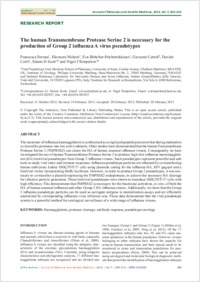The human transmembrane protease serine 2 is necessary for the production of group 2 influenza A virus pseudotypes
- Ferrara, Francesca Viral Pseudotype Unit, Medway School of Pharmacy, University of Kent, Central Avenue, Chatham Maritime, ME4 4TB, UK
- Molesti, Eleonora Viral Pseudotype Unit, Medway School of Pharmacy, University of Kent, Central Avenue, Chatham Maritime, ME4 4TB, UK
- Böttcher-Friebertshäuser, Eva Institute of Virology, Philipps University Marburg, Hans-Meerwein-Str. 2, 35043 Marburg, Germany
- Cattoli, Giovanni FAO-OIE and National Reference Laboratory for Newcastle Disease and Avian Influenza, Istituto Zooprofilattico delle Venezie, Viale dell’Università, 10 35020 Legnaro (PD), Italy
- Corti, Davide Institute for Research in Biomedicine (IRB), Faculty of Biomedical Sciences, Università della Svizzera italiana, Switzerland
- Scott, Simon D. Viral Pseudotype Unit, Medway School of Pharmacy, University of Kent, Central Avenue, Chatham Maritime, ME4 4TB, UK
- Temperton, Nigel J. Viral Pseudotype Unit, Medway School of Pharmacy, University of Kent, Central Avenue, Chatham Maritime, ME4 4TB, UK
-
20.02.2013
Published in:
- Journal of molecular and genetic medicine. - 2013, vol. 7, p. 309-314
English
The monomer of influenza haemagglutinin is synthesized as a single polypeptide precursor that during maturation is cleaved by proteases into two active subunits. Other studies have demonstrated that the human Transmembrane Protease Serine 2 (TMPRSS2) can cleave the HA of human seasonal influenza viruses. Consequently, we have investigated the use of human Transmembrane Protease Serine 2 to produce high titre influenza haemmagglutinin (HA) lentiviral pseudotypes from Group 2 influenza viruses. Such pseudotypes represent powerful and safe tools to study viral entry and immune responses. Influenza pseudotype particles are obtained by co- transfecting human embryonic kidney HEK293T/17 cells using plasmids coding for the influenza HA, HIV gag-pol and a lentiviral vector incorporating firefly luciferase. However, in order to produce Group 2 pseudotypes, it was necessary to co-transfect a plasmid expressing the TMPRSS2 endoprotease, to achieve the necessary HA cleavage for infective particle generation. These lentiviral pseudotypes were shown to transduce HEK293T/17 cells with high efficiency. This demonstrates that TMPRSS2 is necessary for the functional activation, in vitro, of both the HA of human seasonal influenza and other Group 2 HA influenza strains. Additionally, we show that the Group 2 influenza pseudotype particles can be used as surrogate antigens in neutralization assays and are efficiently neutralized by corresponding influenza virus reference sera. These data demonstrate that the viral pseudotype system is a powerful method for serological surveillance of a wide range of influenza viruses.
- Language
-
- English
- Classification
- Medicine
- License
- Open access status
- gold
- Identifiers
-
- RERO DOC 326697
- DOI 10.4172/1747-0862.1000055
- ARK ark:/12658/srd1318868
- Persistent URL
- https://n2t.net/ark:/12658/srd1318868
Statistics
Document views: 191
File downloads:
- Texte intégral: 149
